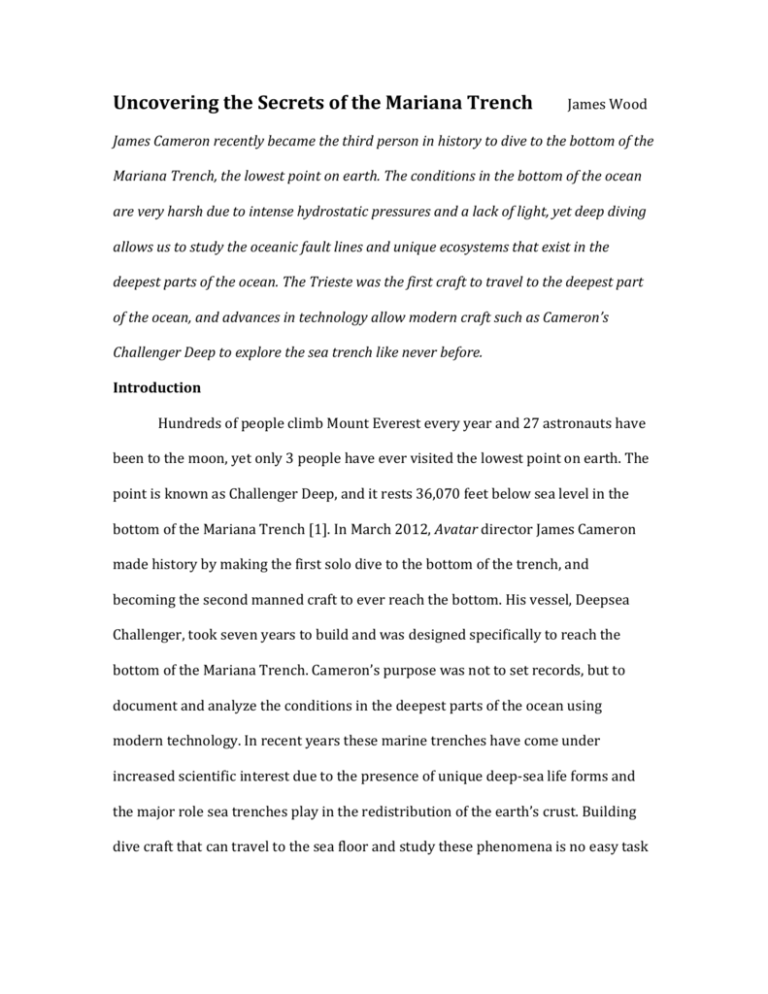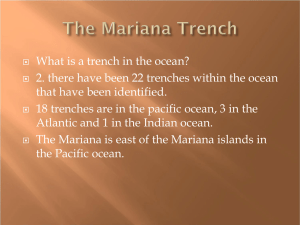Uncovering the Secrets of the Mariana Trench
advertisement

Uncovering the Secrets of the Mariana Trench James Wood James Cameron recently became the third person in history to dive to the bottom of the Mariana Trench, the lowest point on earth. The conditions in the bottom of the ocean are very harsh due to intense hydrostatic pressures and a lack of light, yet deep diving allows us to study the oceanic fault lines and unique ecosystems that exist in the deepest parts of the ocean. The Trieste was the first craft to travel to the deepest part of the ocean, and advances in technology allow modern craft such as Cameron’s Challenger Deep to explore the sea trench like never before. Introduction Hundreds of people climb Mount Everest every year and 27 astronauts have been to the moon, yet only 3 people have ever visited the lowest point on earth. The point is known as Challenger Deep, and it rests 36,070 feet below sea level in the bottom of the Mariana Trench [1]. In March 2012, Avatar director James Cameron made history by making the first solo dive to the bottom of the trench, and becoming the second manned craft to ever reach the bottom. His vessel, Deepsea Challenger, took seven years to build and was designed specifically to reach the bottom of the Mariana Trench. Cameron’s purpose was not to set records, but to document and analyze the conditions in the deepest parts of the ocean using modern technology. In recent years these marine trenches have come under increased scientific interest due to the presence of unique deep-sea life forms and the major role sea trenches play in the redistribution of the earth’s crust. Building dive craft that can travel to the sea floor and study these phenomena is no easy task though, as the conditions 6.8 miles below the surface will crush all but the toughest of submersibles. Why bother exploring the ocean floor? Diving to the deepest part of the ocean might seem like a pointless achievement, but exploring the deep ocean floor is beneficial to society because it will help scientists better understand the world we live in. Water covers more than 70% of the planet’s surface, yet to date we have explored only 5% of the oceans [2]. In particular, deep-sea trenches interest many scientists in the fields of geology and marine biology. The movement of the earth’s tectonic plates forms peaks and valleys in the earth, and areas such as the Mariana Trench are formed when one plate slides beneath a second tectonic plate in a process known as subduction (Figure 1). These “subduction zones” are responsible for most of the active volcanoes on earth as well as most major earthquakes and tsunamis. In fact, 9 of the 10 largest earthquakes of Figure 1: A cross section of the Mariana Trench. The red line shows the Pacific plate being subducted by the Phillipine plate. Credit: Wikipedia the past century have occurred in subduction zones, as did the earthquake and tsunami that recently devastated Japan [3]. By exploring these fault lines and understanding how the plates interact with each other, geologists hope to better understand these natural disasters and more accurately model fault movement in subduction zones. The sea floor is also of great interest to biologists due to the unique life forms that live in the dark depths of the ocean. The average depth of the ocean floor is 12,200 feet, whereas sunlight penetrates only 1,000 feet below the waves [10]. This means that organisms living on the sea floor cannot use the sun as a source of energy and have developed unique alternatives to sustain themselves. For instance, while exploring geothermal vents in the earth, scientists discovered chemosynthetic bacteria that live off of the hydrogen sulfide exhausted from these deep-sea hydrothermal vents. These bacteria provide an energy source for other life forms, and allow for a completely unique ecosystem to thrive near these deep-ocean vents [5]. Scientists hope to analyze the DNA of these unique organisms and other sea creatures in order to understand how they function. Furthermore, the sea floor contains large deposits of oil and minerals, and finding a way to collect them safely and economically would prove to be very profitable. Dangers of the deep Although exploring the ocean floor would greatly benefit society, charting the depths of the sea is no easy task. A deep-sea submersible faces the same problems as any other conventional submarine: an electrical fire, loss of power, or mechanical failure could leave the pilot trapped in the near-freezing depths of the ocean without light or much oxygen. However, the largest problem facing deep-sea submersibles is the incredible pressure at the bottom of the ocean, known as hydrostatic pressure. The physical principle behind hydrostatic pressure can be seen in Figure 2. Water pressure increases in proportion to the height of the water in the column, and the water Figure 2: The column on the right has a higher pressure than the left due to the weight of the water. Credit: www.buildingscience.com at the bottom has to support the weight of the incompressible fluid. At the average ocean floor depth of 12,200 feet, there is a column of water more than 2 miles high pressing down on the sea floor and any submarine that travels there. At this depth, the pressure is 5540 pounds per square inch (psi), or 377 times sea level pressure. To reach the bottom of the Mariana Trench, a vessel such as the Deepsea Challenger needs to be able to withstand over 16,000 psi of pressure or the ship will be crushed like a tin can [9]. The high pressures at the ocean floor also make it difficult for deep-sea submersibles to dive and resurface. The basic physical principle allowing a submersible to function is buoyancy. As seen in Figure 3, a conventional submarine has areas known as ballast tanks that can fill with either air or water, changing the density of the craft and allowing the submarine to dive or surface. In a modern submarine, compressed air is used to flush seawater out of the ballast tanks and allow the submarine to surface. Most modern submarines have maximum depth ratings of less than 2,000 feet, because around that depth the pressure of the water exceeds the pressure of the compressed air, so the water would not be removed and the submarine would sink. For deep-diving vessels such as the Trieste and Deepsea Challenger, the dive mechanism is very simple. Massive weights are attached to bottom of the craft to weigh it down, while the craft itself it is designed to float. With all of the weights attached, the dive vessel sinks to the bottom. When the submersible wants to level out, it drops some of the weights until it stops moving. When the vessel wants to surface, it simply drops the rest of the weights on the ocean floor and floats back up, as seen in Figure 4. However, the weights must be precisely calculated to the maximum depth that the craft wants to achieve, because the density of the craft will increase as the pressure increases [9]. While this method requires refitting the weights after each dive, it remains the fastest and most economical way to reach the sea floor. Figure 3: Cross Section of a submarine. Credit: www.islandnet.com Figure 4: An illustration of the Deepsea Challenger releasing dive weights. Credit: National Geographic The evolution of deep-sea exploration Although the basic physical principles used to reach Challenger Deep haven’t changed in the past 60 years, the technology used in deep-sea divers has allowed the submersibles to become practical scientific instruments. The first craft to ever reach the Mariana trench was the bathyscaphe Trieste, which was built in 1948 and seated two people [12]. It weighed 150 tons and consisted of a giant float suspended over a thick metal diving sphere where the crew was confined (Figure 5). The float was filled with 22,000 gallons of gasoline, which is incompressible and lighter than water, and seawater could be taken in to lower the density as needed [6]. Although the Trieste’s dive was a major feat of engineering, it was not a practical ship for scientific exploration. The Trieste had few lights, no video cameras, and no way to collect samples from the sea floor. The sub spent less than half an hour at Challenger Deep and an ABC report of the dive states that “They [Walsh and Piccard] said at the time that their sub kicked up so much muck that there was almost nothing visible through their thick viewing ports” [8]. However, the development of syntactic foam Figure 5: A comparison of the float-buoyed Trieste and the foam-buoyed Deepsea Challenger. Credit: National Geographic in the 1960s led to a new building material for diving vessels that were both buoyant and durable, eliminating the need for a massive gasoline-filled float. The new material allowed for the development of much smaller craft, outfitted with more modern technology to allow for economical scientific exploration. In addition, advancements in robotics allowed deep-sea craft to be fitted with mechanical arms, enabling them to interact with the environment and collect samples for research. These new compact submersibles such as the DSV Alvin have been used in a number of tasks, ranging from exploring the Titanic to disarming nuclear warheads on the ocean floor. Although data gathered by Alvin has been referenced in over 2,000 scientific papers, the submersible can only dive to a depth of 14,800 feet and thus can only reach 63% of the ocean floor [4]. James Cameron’s Deepsea Challenger builds upon the previous designs of syntactic foam-based craft by using an improved foam that can resist the extreme pressures of the Mariana Trench and allow it to travel anywhere in the ocean. Cameron’s submersible has a sleek aerodynamic design allowing it to descend and resurface much faster than the Trieste, allowing for more time spent on the sea floor. Like Figure 6: Design overview of the Deepsea Challenger Alvin and similar dive robots, the Deepsea Challenger is equipped with a robot arm to collect samples from the Mariana Trench. What makes the submersible unique are the massive light and camera arrays attached to the midsection of the craft (Figure 6). The film director wanted to capture the environment with highdefinition 3D video cameras, and 5 cameras were custom built and attached to the sub so Cameron could bring stunning footage of the Mariana Trench back to the surface. James Cameron hopes to use these cameras to both entertain audiences and further scientific research. Looking to the Future The information gathered from the Deepsea Challenger and similar dive crafts has a myriad of possible applications. For instance, NASA astrobiologist Kevin Hand is currently reviewing James Cameron’s dive footage to see what it might tell us about the possibility of life in the deep oceans of Jupiter’s moon Europa [7]. Since life on earth began in the oceans, understanding how organisms survive and replicate in the harsh conditions of the ocean floor will further scientists’ knowledge of how life developed on earth. Governments have also discussed the prospect of disposing of radioactive waste or excess carbon dioxide by embedding it in the sea floor, but more research is needed to determine the environmental side effects [11]. If the waste could be disposed of with minimal environmental impact, this would temporarily solve many of our hazardous waste problems. Geologists could use the craft to study underwater subduction faults to possibly predict future earthquakes and tsunamis, which could save countless lives. Quite frankly, since so much of the ocean remains a mystery the possibilities are almost endless. Moreover, exploring the ocean is more financially feasible than one might expect. Former director of the National Oceanic and Atmospheric Association Dr. Sylvia Earle recently said: “A fraction of what we invest going skyward would answer some major questions about this part of the Solar System [the ocean].” [1]. Outer space may be the final frontier, but we must first find out what opportunities are hiding beneath the waves. Cameron’s visit to Challenger Deep may have only been the second manned trip in history, but he says it won’t be his last. "It's not a one-time deal and then moving on. This is the beginning of opening up this new frontier" [8]. About the Author: James Wood is an undergraduate at USC majoring in chemical engineering. He enjoys playing rugby, scuba diving, and exploring the great outdoors. Links and key words: Key words: Hydrostatic pressure, subduction Zone, buoyancy, hydrothermal vents, syntactic foam, Challenger Deep, Deepsea Challenger, Trieste, DSV Alvin, Multimedia website: http://www.bbc.co.uk/news/science-environment-17013285 Multimedia website: http://deepseachallenge.com/ Multimedia website: http://abcnews.go.com/Technology/james-cameron-dives-floormariana-trench-deeper-everest/story?id=16003655 Works Cited [1] "Why Go Down?" BBC News Internet: http://www.bbc.co.uk/news/scienceenvironment-17041438, Feb 23, 2012 [April 1, 2012] [2] National Oceanic and Atmospheric Administration. “Ocean Facts.” Internet: http://oceanservice.noaa.gov/facts/exploration.html, Nov 17, 2011 [April 1, 2012] [3] Wikipedia. “Subduction.” Internet: http://en.wikipedia.org/wiki/Subduction, Mar 24, 2011 [April 1, 2012] [4] Woods Hole Oceanographic Institution. “Human Occupied Vehicle Alvin.” Internet: http://www.whoi.edu/alvin/ [April 1, 2012] [5] United States Geological Survey. “Exploring the Deep Ocean Floor." This Dynamic Earth. Internet: http://pubs.usgs.gov/gip/dynamic/exploring.html, Jun 24, 1999 [April 1, 2012] [6] “The Trieste.” Extreme Science Internet: http://www.extremescience.com/trieste.htm [April 1, 2012] [7] Bolden, Charles. “NASA and Challenger Deep.” NASA. Internet: http://blogs.nasa.gov/cm/blog/bolden/posts/post_1332795222025.html, Mar 26, 2012 [April 1, 2012] [8] Potter, Ned. “James Cameron Describes Mariana Trench After Pacific Dive.” ABC News. Internet: http://abcnews.go.com/Technology/james-cameron-dives-floor-marianatrench-deeper-everest/story?id=16003655, Mar 26, 2012 [April 1, 2012] [9] National Geographic. “Sub Facts.” Deepsea Challenge. Internet: http://deepseachallenge.com/the-sub/sub-facts/, Mar. 2012 [April 1, 2012] [10] Smithsonian Institute. “Zones of the Open Ocean.” Ocean Portal. Internet: http://ocean.si.edu/ocean-photos/zones-open-ocean, Jan 1, 2012 [April 1, 2012] [11] National Academy of Engineering. “Develop Carbon Sequestration Methods.” Engineering Grand Challenges. Internet: http://www.engineeringchallenges.org/cms/8996/9077.aspx, [April 1, 2012] [12] United States Naval Department. “Trieste.” Naval History and Heritage Command. Internet: http://www.history.navy.mil/danfs/t8/trieste.htm, [April 1, 2012]








